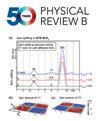Transverse voltage in anisotropic hydrodynamic conductors
IF 3.7
2区 物理与天体物理
Q1 Physics and Astronomy
引用次数: 0
Abstract
Weak momentum dissipation in ultraclean metals gives rise to novel non-Ohmic current flow, including ballistic and hydrodynamic regimes. Recently, hydrodynamic flow has attracted intense interest because it presents a valuable window into the electronic correlations and the longest lived collective modes of quantum materials. However, diagnosing viscous flow is difficult as the macroscopic observables of ballistic and hydrodynamic transport such as the average current distribution can be deceptively similar, even if their respective microscopics deviate notably. Based on kinetic Boltzmann theory, here we propose to address this issue via the transverse channel voltage at zero magnetic field, which can efficiently detect hydrodynamic flow in a number of materials. To this end, we show that the transverse voltage is sensitive to the interplay between anisotropic fermiology and boundary scattering, resulting in a nontrivial behavior in narrow channels along crystalline low-symmetry directions. We discuss several materials where the channel-size dependent stress of the quantum fluid leads to a characteristic sign change of the transverse voltage as a new hallmark of the crossover from the ballistic to the hydrodynamic regime.求助全文
约1分钟内获得全文
求助全文
来源期刊

Physical Review B
物理-物理:凝聚态物理
CiteScore
6.70
自引率
32.40%
发文量
0
审稿时长
3.0 months
期刊介绍:
Physical Review B (PRB) is the world’s largest dedicated physics journal, publishing approximately 100 new, high-quality papers each week. The most highly cited journal in condensed matter physics, PRB provides outstanding depth and breadth of coverage, combined with unrivaled context and background for ongoing research by scientists worldwide.
PRB covers the full range of condensed matter, materials physics, and related subfields, including:
-Structure and phase transitions
-Ferroelectrics and multiferroics
-Disordered systems and alloys
-Magnetism
-Superconductivity
-Electronic structure, photonics, and metamaterials
-Semiconductors and mesoscopic systems
-Surfaces, nanoscience, and two-dimensional materials
-Topological states of matter
 求助内容:
求助内容: 应助结果提醒方式:
应助结果提醒方式:


